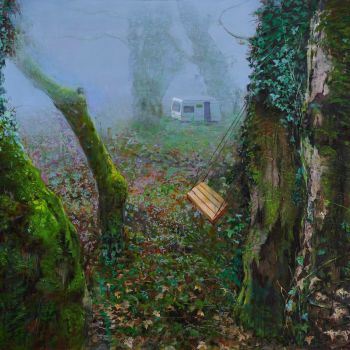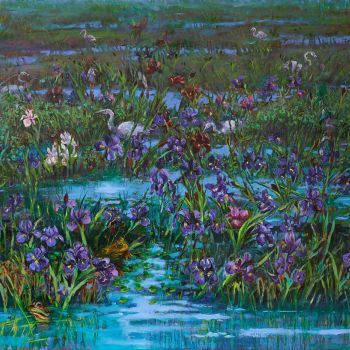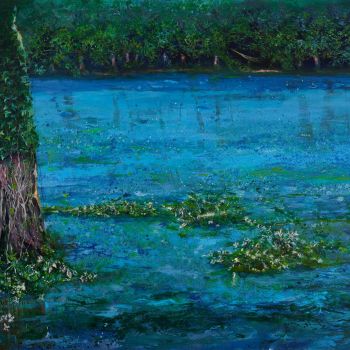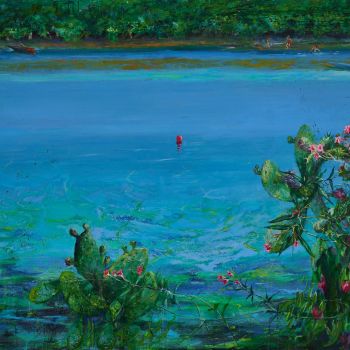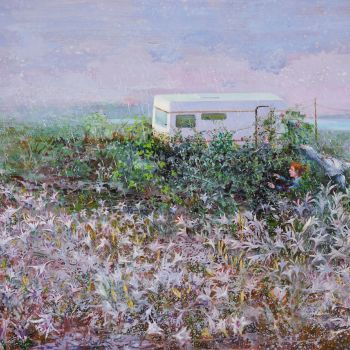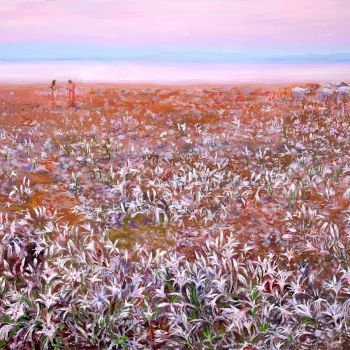Irene’s presence fills space and time unexpectedly, surprisingly, like meadows of fragile sand lilies emerging on the most visited landscapes of Santorini and Rhodes –unexpectedly, surprisingly. We’re not talking about some sort of terra incognita here, an unexplored country; on the contrary. This is the alternate reality created by a new way of seeing things, a power that rearranges and transforms things so that they speak many more stories than at first sight. The gaze of the painter and the gaze of the traveller run parallel in this sense. This is, after all, the noticeable difference between those two and an ordinary visitor. In reality, there are no new places to be discovered; only new gazes to be entertained, to embrace familiar landscapes and transform them into novel ones, both mentally and on the canvas.
And yet our trip with Irene towards near and far, the real and the unreal, is an experience way more complicated than that of a simple traveller – for the freedom found in art is inexhaustible. When one is bestowed with the privilege of seeing the birth pangs of the new and different, the efforts behind her persistent, limpid sort of painting, and the painful conversation she has with the canvas, the mysteries of her work grow deeper rather than being solved. Of course her works speak for themselves; they’re autonomous and self-existent from the moment of their release from the painter's workshop; and they can become truly great when they converse, on an equal footing, with any well-meaning spectator standing in front of them. We might be anxious to find out what they have to impart – as when two people converse intimately – but that’s their own business. As far as we are concerned, painting has once more fulfilled its most magical role: to create a chemistry between the art of the creator and the experiential load of the unskilled spectator.
In the workshop, Irene stands alone with her works. She paints for painting’s sake, and for the sake of herself: for nothing great, original, authentic, or indelible can ever emerge from a mind that remains trained to the viewer. I often hear her say, "this is a beautiful landscape, but nothing more." She means that perhaps everyone would like to be kept company by such a work, but for the dedicated creator, repeating what she’s already conquered and knows to do well, is utterly boring. The challenge is to challenge Painting itself. The struggle is not with the image itself, but with the body of the painting, its character, its matière. And the great thing about Irene’s art is that winning this struggle does not only enrich the creator herself, or the limited circle of art experts, but the very experience of what Painting is for the entire audience. Irene has her own distinctive, inimitable artistic personality, but her paintings concern us all. Her works can become ours. She lights up the mysteries of the art of painting, deepening, as if by magic, our own aesthetic satisfaction.
Irene’s works spring from unfulfilled images into which she, slowly and torturously, breathes soul. In contrast to her character, her movements are nervous and often cataclysmic within this ritual universe. Water is a building block in her creative universe, both in the finished work but also during the process of creation. The flowing blue and greens are coloured components of the dream. Every element (or spectre) is repeatedly sacrificed, lost and transformed, until it becomes artistically better, that is until it comes to life. And while everything repeats, surprising elements spring up and dominate the work almost naturally, changing its atmosphere. And yet these surprises are paradoxically and organically tied to the whole, as if they were always there, as if simply waiting to emerge.
Surprise becomes, thus, one of her many consecutive motifs. Surprise bestows life and ideology to her work. Irene’s works might evolve into natural and urban landscapes, but they are fully anthropocentric. Man, and his morals, is the measure of all things. One often encounters visible forms in her paintings, but where such do not exist, their aura and energy are still prominent. It’s an energy reminiscent of a wind fluttering the veils of mystery – perhaps even melancholy – a benign wind that caresses the eyes and the soul. And if some works (especially some watercolours) appear carefree, perhaps even idyllic, they still embody a strict artistic ethic which, paradoxically, delights, excites and moves us. For those who know Irene, this simply means that she consistently makes her life and personality operative, which goes to say authentic. Which means that she transforms them, simply, into Art.
Nikos G. Mastropavlos
Journalist



